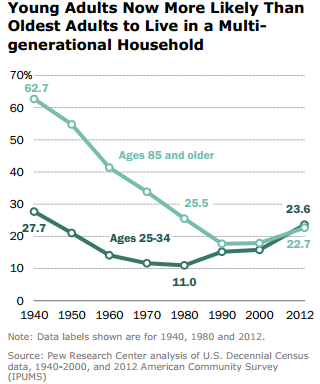Millennials Still Moving in with Mom and Dad
Back in 1980, 28 million Americans lived in multi-generational households. Now, a study finds, that number has doubled: It hit a record of 56.8 million people in 2012 as more and more young adults, ages 25 to 34, bunked with their parents.
“By 2012, roughly one in four of these young adults (23.6 percent) lived in multi-generational households, up from 18.7 percent in 2007 and 11 percent in 1980,” according to the report from the Pew Research Center, which analyzed U.S. Census Bureau data.
Pew defines multi-generational households as those where at least two adult generations (parents and their adult children), or two non-sequential generations (grandparents and grandchildren) live together. For decades, the oldest Americans -- ages 85 and older -- were those most likely to reside in a multi-generational home.
That’s no longer the case: Younger adults have overtaken the elderly on this front. “In 2012, 22.7 percent of adults ages 85 and older lived in a multi-generational household, just shy of the 23.6 percent of adults ages 25 to 34 in the same situation,” Pew finds.

Since the years of the Great Recession, the growth in multi-generational arrangements has slowed somewhat. Between 2007 and 2010, this population surged by more than 2 million people per year. Since 2010, however, the multi-generational-dwelling population been growing by about 1 million per year.
Still, young adults have dominated the post-recession increase in multi-generational living. From 2010 to 2012, the percentage of 25- to 34-year-olds in that situation rose 2 percent (from 21.6 to 23.6) -- the largest increase of any age group. Compared to 30 years ago, young adults are also “substantially more likely than the general population (18.1 percent) to live in these types of households,” according to the study.
The continued growth in multi-generational households is one sign that “[economic] recovery remains fragile, or elusive, for a large segment of the American population,” said Pew senior economist Richard Fry, who co-authored the study.
Such arrangements function as a kind of “private social safety net,” he said, adding, “When people are struggling in the labor market, one of the ways they compensate is by living with family.”
In addition to economic troubles, long-term demographic changes are also driving the rise in multi-generational homes. Immigrants “have been much more likely to live in multi-generational households than U.S.-borns,” Fry said, and the share of households headed by an immigrant doubled between 1980 (7 percent) and 2012 (14 percent).
Racial and ethnic minorities are also more likely to live in multi-generational households than non-Hispanic whites, and their share of the U.S. population has risen from 20 percent in 1980 to 37 percent today, the report states.
© Copyright IBTimes 2024. All rights reserved.





















